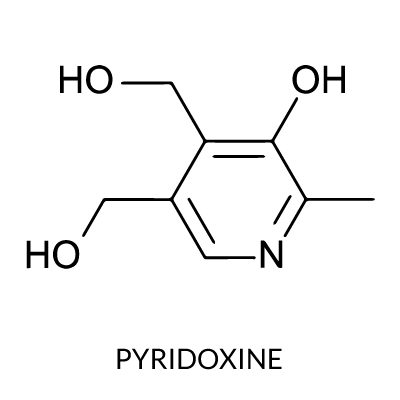Vitamin B6, also called pyridoxine, is one of eight water-soluble B vitamins.
Vitamin B6 refers to a group of three compounds: pyridoxol (pyridoxine), pyridoxal and pyridoxamine. Vitamin B6 helps the body make several neurotransmitters, chemicals that carry signals from one nerve cell to another. It is needed for normal brain development and function, and helps the body make the hormones serotonin and norepinephrine, which influence mood, and melatonin, which helps regulate the body clock. It is required by several enzymes, including those involved in the breakdown of amino acids.
Clinical Signs of Pyridoxine Deficiency
Chicks fed a vitamin B6-deficient diet have little appetite poor growth, chondrodystrophy, and characteristic nervous behavior. Chicks may show jerky, nervous movements of the legs, run aimlessly about, flapping their wings, or squatting with their wings slightly spread out and their heads resting on the ground. Chronic borderline B6 deficiency produces perosis; usually one leg is severely crippled, and one or both of the middle toes may be bent inward at the first joint.
Pyridoxine Dietary Recommendations
Vitamin B6 requirements generally vary from 2.5 to 4.5 mg /kg (1.4 to 2 mg/lb) of diet (NRC, 1994). However more modern research studies as conducted by DSM Nutrition, recommend the following:
| Age/Life Stage | mg/kg |
|---|
| Newly Hatched Chicks (0 - 10 wks) | 4.5-5.5 |
| Young & Growing (10 - 20 wks) | 3.0-5 |
| Adults | 3.5-6 |
|
Vitamin B6 requirements in chickens are increased when chickens are fed:
- High-protein diets
- Imbalanced amino acid profile
- High amounts of tryptophan or methionine
The amount of vitamin B6 required is influenced by the percentage of protein in the chicks diet. Chicks on a high protein level require increased amounts of vitamin B6, since vitamin B6 is needed to breakdown the amino acids. In addition, depending on the breed of chicken, it might require increased vitamin B6. Lucas et al. (1946) found that crossbred chicks (Rhode Island Red x Barred Plymouth Rock) showed a considerably higher requirement for pyridoxine (B6) than had previously been found for White Leghorn chicks.
Pyridoxine Food Sources
Most feedstuff contain enough vitamin B6. The best sources are obtained from vegetables, whole grain, cereals and their by-products and nuts. The richest source is royal jelly produced by bees. The bioavalibility of vitamin B6 in soybean meal-based feed is 65 percent and in corn-based feed it varies from 45 to 56 percent.

